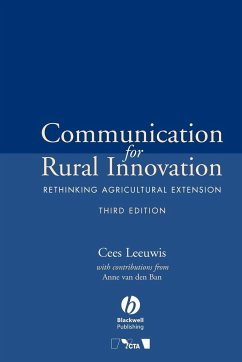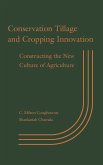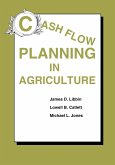- Broschiertes Buch
- Merkliste
- Auf die Merkliste
- Bewerten Bewerten
- Teilen
- Produkt teilen
- Produkterinnerung
- Produkterinnerung
Agricultural extension acts as a very important tool in rural development by educating farmers to produce better crops and more productive animals at a lower cost. The latest edition of Communication for Rural Innovation: Rethinking Agricultural Extension, asks readers to take a fresh look at agricultural extension and rethink ideas about the role and meaning of extension in today's industry.
This important book is the re-titled third edition of the extremely well received and widely used Agricultural Extension (van den Ban & Hawkins, 1988, 1996). Building on the previous editions,…mehr
Andere Kunden interessierten sich auch für
![Horticultural Reviews, Volume 15 Horticultural Reviews, Volume 15]() Horticultural Reviews, Volume 15381,99 €
Horticultural Reviews, Volume 15381,99 €![Farm Machinery 12e P Farm Machinery 12e P]() Claude CulpinFarm Machinery 12e P79,99 €
Claude CulpinFarm Machinery 12e P79,99 €![Sustainable Agriculture in Temperate Zones Sustainable Agriculture in Temperate Zones]() Sustainable Agriculture in Temperate Zones331,99 €
Sustainable Agriculture in Temperate Zones331,99 €![Horticultural Reviews, Volume 14 Horticultural Reviews, Volume 14]() Horticultural Reviews, Volume 14381,99 €
Horticultural Reviews, Volume 14381,99 €![The World Food Economy The World Food Economy]() Douglas D SouthgateThe World Food Economy98,99 €
Douglas D SouthgateThe World Food Economy98,99 €![Conservation Tillage and Cropping Innovation Conservation Tillage and Cropping Innovation]() C Milton CoughenourConservation Tillage and Cropping Innovation138,99 €
C Milton CoughenourConservation Tillage and Cropping Innovation138,99 €![Cash Flow Planning in Agriculture Cash Flow Planning in Agriculture]() James D LibbinCash Flow Planning in Agriculture101,99 €
James D LibbinCash Flow Planning in Agriculture101,99 €-
-
-
Agricultural extension acts as a very important tool in rural development by educating farmers to produce better crops and more productive animals at a lower cost. The latest edition of Communication for Rural Innovation: Rethinking Agricultural Extension, asks readers to take a fresh look at agricultural extension and rethink ideas about the role and meaning of extension in today's industry.
This important book is the re-titled third edition of the extremely well received and widely used Agricultural Extension (van den Ban & Hawkins, 1988, 1996). Building on the previous editions, Communication for Rural Innovation maintains and adapts the insights and conceptual models of value today, while reflecting many new ideas, angles and modes of thinking concerning how agricultural extension is taught and carried through today. Since the previous edition of the book, the number and type of organisations that apply communicative strategies to foster change and development in agriculture and resource management has become much more varied and this book is aimed at those who use communication to facilitate change in agriculture and resource management. Communication for Rural Innovation is essential reading for process facilitators, communication division personnel, knowledge managers, training officers, consultants, policy makers, extension specialists and managers of agricultural extension or research organisations. The book can also be used as an advanced introduction into issues of communicative intervention at BSc or MSc level.
Hinweis: Dieser Artikel kann nur an eine deutsche Lieferadresse ausgeliefert werden.
This important book is the re-titled third edition of the extremely well received and widely used Agricultural Extension (van den Ban & Hawkins, 1988, 1996). Building on the previous editions, Communication for Rural Innovation maintains and adapts the insights and conceptual models of value today, while reflecting many new ideas, angles and modes of thinking concerning how agricultural extension is taught and carried through today. Since the previous edition of the book, the number and type of organisations that apply communicative strategies to foster change and development in agriculture and resource management has become much more varied and this book is aimed at those who use communication to facilitate change in agriculture and resource management. Communication for Rural Innovation is essential reading for process facilitators, communication division personnel, knowledge managers, training officers, consultants, policy makers, extension specialists and managers of agricultural extension or research organisations. The book can also be used as an advanced introduction into issues of communicative intervention at BSc or MSc level.
Hinweis: Dieser Artikel kann nur an eine deutsche Lieferadresse ausgeliefert werden.
Produktdetails
- Produktdetails
- Verlag: Wiley
- 3rd edition
- Seitenzahl: 432
- Erscheinungstermin: 1. Dezember 2004
- Englisch
- Abmessung: 234mm x 156mm x 23mm
- Gewicht: 646g
- ISBN-13: 9780632052493
- ISBN-10: 063205249X
- Artikelnr.: 21255979
- Herstellerkennzeichnung
- Libri GmbH
- Europaallee 1
- 36244 Bad Hersfeld
- gpsr@libri.de
- Verlag: Wiley
- 3rd edition
- Seitenzahl: 432
- Erscheinungstermin: 1. Dezember 2004
- Englisch
- Abmessung: 234mm x 156mm x 23mm
- Gewicht: 646g
- ISBN-13: 9780632052493
- ISBN-10: 063205249X
- Artikelnr.: 21255979
- Herstellerkennzeichnung
- Libri GmbH
- Europaallee 1
- 36244 Bad Hersfeld
- gpsr@libri.de
Cees Leeuwis is the author of Communication for Rural Innovation: Rethinking Agricultural Extension, 3rd Edition, published by Wiley. Anne Willem van den Ban was a Dutch scholar, whose work focused on agricultural extension.
Preface x
The CTA xii
Part 1 Rethinking Extension 1
1 Introduction 3
1.1 Challenges for agricultural extension practice 3
1.1.1 Challenges for farmers and agriculture at large 3
1.1.2 Reinventing extension 11
1.1.3 In conclusion: a new societal function for extension 17
1.2 Objectives and outline of this book 18
Questions for discussion 21
2 From extension to communication for innovation 22
2.1 Historical roots and evolving conceptions of extension 22
2.1.1 Origins, early meanings and international terminology 22
2.1.2 Evolving definitions 23
2.2 Different types of communication services and strategies 29
2.2.1 Basic rationale of different communication services and strategies 31
2.3 Agricultural knowledge systems and other extension-related concepts 36
Questions for discussion 39
3 The ethics and politics of communication for innovation 40
3.1 The political implications of communication for innovation 40
3.2 The acceptability of government communicative intervention 42
3.3 The acceptability of non-governmental communicative intervention 43
3.4 Professional standards 45
3.5 Dilemmas regarding ethics and politics: an example 46
Questions for discussion 48
4 The role of communicative intervention in policy planning: instrumental
and interactive approaches 49
4.1 Top-down planning and instrumental communication 49
4.1.1 'Blueprint' planning and problem solving 49
4.1.2 The instrumental model of communicative intervention 50
4.1.3 In conclusion 53
4.2 Process management and interactive communication 53
4.2.1 Process management towards innovation 53
4.2.2 Arguments for an interactive model of communicative intervention 55
4.2.3 In conclusion 56
4.3 Shortcomings and conditions: the relation between interactive and
instrumental approaches 57
Questions for discussion 58
Part 2 The Relations Between Human Practice, Knowledge and Communication 59
5 Understanding human practices: the example of farming 61
5.1 Different levels and domains of farming practice 61
5.1.1 Farming practices at different hierarchical levels 62
5.1.2 Different domains of farming practice 63
5.1.3 Farming practices at different points in time 64
5.2 Understanding the social nature of technical practices 65
5.2.1 Evaluative frame of reference: the basis for reasoning about
practices 67
5.2.2 Perceived effectiveness of the social environment 71
5.2.3 Perceived self-efficacy 74
5.2.4 Social relationships and perceived social pressure 76
5.2.5 The dynamics within the model 79
5.3 Implications for communication for innovation 86
5.3.1 The central role of knowledge and the need to be modest 86
5.3.2 The relationship with different communication strategies and
functions 86
5.3.3 Communicative intervention must be 'tuned' to other communication
processes 88
5.3.4 The need to anticipate diversity among farmers 89
5.3.5 Linking multiple socio-technical innovation processes 89
5.3.6 The multi-layered character of technology and policy acceptance 90
5.3.7 The illusion of supporting rational decision-making 91
5.3.8 The need for analytical capacity in communication for innovation
organisations 92
Questions for discussion 92
6 Knowledge and perception 94
6.1 Knowledge, perception, information and wisdom 94
6.2 Life-worlds: the locus of discursive (explicit) and practical (tacit)
knowledge 96
6.3 Multiple realities and knowledge construction 98
6.4 Knowledge and ignorance 100
6.5 Epistemic cultures: scientists' versus non-scientists' knowledge 105
6.6 Knowledge, power, agency and structure 107
6.7 Practical relevance: the case of farmer experimentation in
environmental co-operatives 110
Questions for discussion 116
7 Communication and the construction of meaning 117
7.1 What is communication? 117
7.2 Three models of communication 121
7.3 Some basic anticipation problems in communicative intervention 123
Questions for discussion 125
Part 3 Innovation as a Process of Network Building, Social Learning and
Negotiation 127
8 Changing perspectives on innovation 129
8.1 The 'adoption and diffusion of innovations' tradition 129
8.1.1 Key conclusions drawn from adoption and diffusion research 130
8.1.2 Critical reflections and practical limitations 134
8.2 Innovations and processes of innovation design 140
8.2.1 The multi-dimensional character of innovations 141
8.2.2 Building effective linkages and networks in an evolutionary process
141
8.2.3 The need for temporary protection in innovation processes 142
8.2.4 Different types of innovations and innovation decisions 143
8.2.5 The problem-driven character of innovation 143
8.2.6 The 'hidden' nature of building blocks for innovation 144
8.2.7 Basic tasks in interactive innovation design processes 144
Questions for discussion 145
9 Social and individual learning 147
9.1 A basic model for adult experiential learning 149
9.2 Levels of learning, and the relationship with decision-making 151
9.3 The centrality of relevant feedback 153
9.4 Factors that may affect learning (pre-conditions and obstacles) 155
9.5 Aspects of learning 161
Questions for discussion 162
10 Negotiation within interactive processes 163
10.1 Why look at negotiation? 163
10.1.1 Conflict-related frictions in interactive innovation processes: six
cases 163
10.1.2 Towards a better language to deal with conflict 168
10.2 Distributive and integrative negotiations 169
10.2.1 Facilitation tasks in integrative negotiations 170
10.2.2 The status of facilitation tasks and guidelines 171
10.2.3 Layers or types of conflict 171
10.3 Pre-conditions for integrative negotiation 172
10.3.1 Divergence of interests 173
10.3.2 Mutual interdependence 173
10.3.3 Ability to communicate 174
10.3.4 Institutional space for using innovative negotiation results 174
10.3.5 An implication: the 'political' dimension of facilitation 175
Questions for discussion 176
11 The role of outsiders and different intervention approaches 177
11.1 The relationship between instrumental/persuasive and interactive
models: alternation and sequencing 177
11.2 The role and expertise of 'insiders' and 'outsiders' 179
11.2.1 Different areas of knowledge and competence needed in intervention
179
11.2.2 From 'experts' and 'laymen' to 'outsiders' and 'insiders' 181
11.2.3 The role and contribution of external facilitators and scientists
181
Questions for discussion 185
Part 4 Media, Methods and Process Management 187
12 The potential of basic communication forms and media 189
12.1 Conventional mass media 190
12.1.1 The way mass media work 191
12.1.2 Functional qualities in relation to communicative intervention 192
12.1.3 Basic guidelines for presenting messages through written mass media
194
12.2 Interpersonal communication 196
12.2.1 Functional qualities in relation to communicative intervention 196
12.2.2 Basic modes of administrating group and bilateral meetings 198
12.2.3 Skills needed for facilitating interpersonal communication 200
12.3 Hybrid media: the internet 202
12.3.1 Modalities of the internet 203
12.3.2 Functional qualities of hybrid media 204
12.3.3 Internet applications for communicative intervention 205
12.4 Media access and audience selectivity 207
12.5 Media mixes 208
Questions for discussion 208
13 Communication for innovation methods 209
13.1 Clarifying the terminology used 209
13.2 Reasons to focus on methods, functions and process management 211
13.3 Specific methods and issues related to farm management communication
212
13.3.1 Advisory communication 213
13.3.2 Supporting horizontal knowledge exchange 217
13.4 Methods related to raising awareness and consciousness of pre-defined
issues 220
13.4.1 Mass media campaigns 220
13.4.2 Entertainment-education 221
13.4.3 Visualising what is difficult to see 222
13.4.4 Result demonstrations/demonstration experiments 222
13.5 Methods related to the exploration of views and issues 224
13.5.1 Analysis of everyday talk 224
13.5.2 In-depth interviewing 225
13.5.3 Metaplan cards 226
13.5.4 Open space technology 226
13.5.5 Visual diagramming and mapping 227
13.5.6 Ranking and scoring techniques 230
13.5.7 Socio-technical problem tree analysis 231
13.5.8 Joint research and on-farm experimentation 233
13.5.9 Public debates 237
13.5.10 Future explorations 238
13.5.11 A caveat: be aware of ritualistic use of exploratory methods 241
13.6 Methods related to information provision 242
13.6.1 Written and computer-based search and access facilities 243
13.6.2 Information-needs assessment 243
13.7 Methods related to training 245
13.7.1 Method demonstrations 245
13.7.2 Experiential practicals 245
Questions for discussion 246
14 The management of interactive innovation processes 247
14.1 Some limitations of conventional thinking on participation 248
14.1.1 Defining 'participation' 249
14.1.2 Types and levels of participation 250
14.1.3 Is 'maximum participation' possible and desirable? 251
14.1.4 Reservations at the theoretical level: strategic versus
communicative action 256
14.2 Guidelines for the facilitation of interactive processes 259
14.2.1 Task 1: Preparing the process 259
14.2.2 Task 2: Reaching and maintaining process agreements 263
14.2.3 Task 3: Joint exploration and situation analysis 265
14.2.4 Task 4: Joint fact-finding and uncertainty reduction 270
14.2.5 Task 5: Forging agreement 271
14.2.6 Task 6: Communication of representatives with constituencies 272
14.2.7 Task 7: Co-ordinated action 273
Questions for discussion 274
15 The planning of individual activities 275
15.1 The purpose of an activity 276
15.1.1 Goal hierarchies 276
15.1.2 Communicative and other means or objectives 277
15.2 Stakeholders, audiences, and targeting 279
15.2.1 Characterising relevant diversity 280
15.2.2 Different types of target audiences 285
15.3 Content 285
15.4 Media and methods 287
15.5 Organisation and logistics 288
15.6 Pre-testing elements of activities 289
Questions for discussion 290
Part 5 Organisational and Interorganisational Issues 291
16 Organisational management, learning and research 293
16.1 Co-ordination in organisations: the significance of 'structure' and
'culture' 293
16.2 Images of organisation and the nature of management 295
16.2.1 Organisations as machines/hard systems thinking 295
16.2.2 Organisations as organisms/functionalist systems thinking 296
16.2.3 Organisations as flux and transformation/soft systems thinking 297
16.2.4 Organisations as political systems/critical systems thinking 298
16.2.5 Organisations as brains or psychic prisons/cognitive or autopoietic
systems thinking 299
16.2.6 Conclusion: the implications of different images 301
16.3 The importance of (re)formulating missions 301
16.3.1 Extension in crisis: the need for change and continuity 302
16.3.2 Organisational implications of a novel mission 303
16.4 The challenge of learning organisations: embracing tension 306
16.4.1 Looking for and creating tension: some practical hints 308
16.4.2 Creating opportunities and conducive conditions: practical hints 311
16.5 Organisational research, monitoring and evaluation 314
16.5.1 Why deviate from the conventional M&E terminology? 316
16.5.2 Key questions to ask in decision-oriented research 318
Questions for discussion 320
17 Agricultural knowledge and information systems 321
17.1 Knowledge and information systems thinking 321
17.2 Rapid Appraisal of Agricultural Knowledge Systems (RAAKS) 324
17.3 Networking in knowledge systems 326
Questions for discussion 328
18 Privatisation and the emergence of 'knowledge markets' 329
18.1 Economic theory and the commoditisation of knowledge 329
18.2 Public and private forms of financing communicative intervention 332
18.3 Privatisation in research 336
18.4 Initial observations regarding emerging knowledge markets 337
18.5 Reflections on the commoditisation of knowledge 345
Questions for discussion 349
19 Co-operation across scientific disciplines and epistemic communities 350
19.1 Methodological differences between the social and the natural sciences
350
19.2 What does cross-disciplinary co-operation entail? 354
19.3 Obstacles for cross-disciplinary co-operation 356
Questions for discussion 361
Part 6 Epilogue 363
20 Approaches and issues for further conceptual research 365
20.1 Overall focus: communication and processes of socio-technical design
365
20.2 The role of theory in formulating specific areas and questions for
research 366
20.3 A note on research design and methodology: towards 'comparative
process ethnography' 373
20.4 Process ethnography as network analysis 375
20.4.1 Classical network analysis: describing interaction patterns among
human actors 376
20.4.2 Analysing networks of interrelated events 377
20.4.3 Looking at the building of networks of human and non-human 'agents'
378
20.4.4 Following knowledge constructs and perceptions in networks 380
20.4.5 Conclusion 381
Questions for discussion 381
References 382
Index 405
The CTA xii
Part 1 Rethinking Extension 1
1 Introduction 3
1.1 Challenges for agricultural extension practice 3
1.1.1 Challenges for farmers and agriculture at large 3
1.1.2 Reinventing extension 11
1.1.3 In conclusion: a new societal function for extension 17
1.2 Objectives and outline of this book 18
Questions for discussion 21
2 From extension to communication for innovation 22
2.1 Historical roots and evolving conceptions of extension 22
2.1.1 Origins, early meanings and international terminology 22
2.1.2 Evolving definitions 23
2.2 Different types of communication services and strategies 29
2.2.1 Basic rationale of different communication services and strategies 31
2.3 Agricultural knowledge systems and other extension-related concepts 36
Questions for discussion 39
3 The ethics and politics of communication for innovation 40
3.1 The political implications of communication for innovation 40
3.2 The acceptability of government communicative intervention 42
3.3 The acceptability of non-governmental communicative intervention 43
3.4 Professional standards 45
3.5 Dilemmas regarding ethics and politics: an example 46
Questions for discussion 48
4 The role of communicative intervention in policy planning: instrumental
and interactive approaches 49
4.1 Top-down planning and instrumental communication 49
4.1.1 'Blueprint' planning and problem solving 49
4.1.2 The instrumental model of communicative intervention 50
4.1.3 In conclusion 53
4.2 Process management and interactive communication 53
4.2.1 Process management towards innovation 53
4.2.2 Arguments for an interactive model of communicative intervention 55
4.2.3 In conclusion 56
4.3 Shortcomings and conditions: the relation between interactive and
instrumental approaches 57
Questions for discussion 58
Part 2 The Relations Between Human Practice, Knowledge and Communication 59
5 Understanding human practices: the example of farming 61
5.1 Different levels and domains of farming practice 61
5.1.1 Farming practices at different hierarchical levels 62
5.1.2 Different domains of farming practice 63
5.1.3 Farming practices at different points in time 64
5.2 Understanding the social nature of technical practices 65
5.2.1 Evaluative frame of reference: the basis for reasoning about
practices 67
5.2.2 Perceived effectiveness of the social environment 71
5.2.3 Perceived self-efficacy 74
5.2.4 Social relationships and perceived social pressure 76
5.2.5 The dynamics within the model 79
5.3 Implications for communication for innovation 86
5.3.1 The central role of knowledge and the need to be modest 86
5.3.2 The relationship with different communication strategies and
functions 86
5.3.3 Communicative intervention must be 'tuned' to other communication
processes 88
5.3.4 The need to anticipate diversity among farmers 89
5.3.5 Linking multiple socio-technical innovation processes 89
5.3.6 The multi-layered character of technology and policy acceptance 90
5.3.7 The illusion of supporting rational decision-making 91
5.3.8 The need for analytical capacity in communication for innovation
organisations 92
Questions for discussion 92
6 Knowledge and perception 94
6.1 Knowledge, perception, information and wisdom 94
6.2 Life-worlds: the locus of discursive (explicit) and practical (tacit)
knowledge 96
6.3 Multiple realities and knowledge construction 98
6.4 Knowledge and ignorance 100
6.5 Epistemic cultures: scientists' versus non-scientists' knowledge 105
6.6 Knowledge, power, agency and structure 107
6.7 Practical relevance: the case of farmer experimentation in
environmental co-operatives 110
Questions for discussion 116
7 Communication and the construction of meaning 117
7.1 What is communication? 117
7.2 Three models of communication 121
7.3 Some basic anticipation problems in communicative intervention 123
Questions for discussion 125
Part 3 Innovation as a Process of Network Building, Social Learning and
Negotiation 127
8 Changing perspectives on innovation 129
8.1 The 'adoption and diffusion of innovations' tradition 129
8.1.1 Key conclusions drawn from adoption and diffusion research 130
8.1.2 Critical reflections and practical limitations 134
8.2 Innovations and processes of innovation design 140
8.2.1 The multi-dimensional character of innovations 141
8.2.2 Building effective linkages and networks in an evolutionary process
141
8.2.3 The need for temporary protection in innovation processes 142
8.2.4 Different types of innovations and innovation decisions 143
8.2.5 The problem-driven character of innovation 143
8.2.6 The 'hidden' nature of building blocks for innovation 144
8.2.7 Basic tasks in interactive innovation design processes 144
Questions for discussion 145
9 Social and individual learning 147
9.1 A basic model for adult experiential learning 149
9.2 Levels of learning, and the relationship with decision-making 151
9.3 The centrality of relevant feedback 153
9.4 Factors that may affect learning (pre-conditions and obstacles) 155
9.5 Aspects of learning 161
Questions for discussion 162
10 Negotiation within interactive processes 163
10.1 Why look at negotiation? 163
10.1.1 Conflict-related frictions in interactive innovation processes: six
cases 163
10.1.2 Towards a better language to deal with conflict 168
10.2 Distributive and integrative negotiations 169
10.2.1 Facilitation tasks in integrative negotiations 170
10.2.2 The status of facilitation tasks and guidelines 171
10.2.3 Layers or types of conflict 171
10.3 Pre-conditions for integrative negotiation 172
10.3.1 Divergence of interests 173
10.3.2 Mutual interdependence 173
10.3.3 Ability to communicate 174
10.3.4 Institutional space for using innovative negotiation results 174
10.3.5 An implication: the 'political' dimension of facilitation 175
Questions for discussion 176
11 The role of outsiders and different intervention approaches 177
11.1 The relationship between instrumental/persuasive and interactive
models: alternation and sequencing 177
11.2 The role and expertise of 'insiders' and 'outsiders' 179
11.2.1 Different areas of knowledge and competence needed in intervention
179
11.2.2 From 'experts' and 'laymen' to 'outsiders' and 'insiders' 181
11.2.3 The role and contribution of external facilitators and scientists
181
Questions for discussion 185
Part 4 Media, Methods and Process Management 187
12 The potential of basic communication forms and media 189
12.1 Conventional mass media 190
12.1.1 The way mass media work 191
12.1.2 Functional qualities in relation to communicative intervention 192
12.1.3 Basic guidelines for presenting messages through written mass media
194
12.2 Interpersonal communication 196
12.2.1 Functional qualities in relation to communicative intervention 196
12.2.2 Basic modes of administrating group and bilateral meetings 198
12.2.3 Skills needed for facilitating interpersonal communication 200
12.3 Hybrid media: the internet 202
12.3.1 Modalities of the internet 203
12.3.2 Functional qualities of hybrid media 204
12.3.3 Internet applications for communicative intervention 205
12.4 Media access and audience selectivity 207
12.5 Media mixes 208
Questions for discussion 208
13 Communication for innovation methods 209
13.1 Clarifying the terminology used 209
13.2 Reasons to focus on methods, functions and process management 211
13.3 Specific methods and issues related to farm management communication
212
13.3.1 Advisory communication 213
13.3.2 Supporting horizontal knowledge exchange 217
13.4 Methods related to raising awareness and consciousness of pre-defined
issues 220
13.4.1 Mass media campaigns 220
13.4.2 Entertainment-education 221
13.4.3 Visualising what is difficult to see 222
13.4.4 Result demonstrations/demonstration experiments 222
13.5 Methods related to the exploration of views and issues 224
13.5.1 Analysis of everyday talk 224
13.5.2 In-depth interviewing 225
13.5.3 Metaplan cards 226
13.5.4 Open space technology 226
13.5.5 Visual diagramming and mapping 227
13.5.6 Ranking and scoring techniques 230
13.5.7 Socio-technical problem tree analysis 231
13.5.8 Joint research and on-farm experimentation 233
13.5.9 Public debates 237
13.5.10 Future explorations 238
13.5.11 A caveat: be aware of ritualistic use of exploratory methods 241
13.6 Methods related to information provision 242
13.6.1 Written and computer-based search and access facilities 243
13.6.2 Information-needs assessment 243
13.7 Methods related to training 245
13.7.1 Method demonstrations 245
13.7.2 Experiential practicals 245
Questions for discussion 246
14 The management of interactive innovation processes 247
14.1 Some limitations of conventional thinking on participation 248
14.1.1 Defining 'participation' 249
14.1.2 Types and levels of participation 250
14.1.3 Is 'maximum participation' possible and desirable? 251
14.1.4 Reservations at the theoretical level: strategic versus
communicative action 256
14.2 Guidelines for the facilitation of interactive processes 259
14.2.1 Task 1: Preparing the process 259
14.2.2 Task 2: Reaching and maintaining process agreements 263
14.2.3 Task 3: Joint exploration and situation analysis 265
14.2.4 Task 4: Joint fact-finding and uncertainty reduction 270
14.2.5 Task 5: Forging agreement 271
14.2.6 Task 6: Communication of representatives with constituencies 272
14.2.7 Task 7: Co-ordinated action 273
Questions for discussion 274
15 The planning of individual activities 275
15.1 The purpose of an activity 276
15.1.1 Goal hierarchies 276
15.1.2 Communicative and other means or objectives 277
15.2 Stakeholders, audiences, and targeting 279
15.2.1 Characterising relevant diversity 280
15.2.2 Different types of target audiences 285
15.3 Content 285
15.4 Media and methods 287
15.5 Organisation and logistics 288
15.6 Pre-testing elements of activities 289
Questions for discussion 290
Part 5 Organisational and Interorganisational Issues 291
16 Organisational management, learning and research 293
16.1 Co-ordination in organisations: the significance of 'structure' and
'culture' 293
16.2 Images of organisation and the nature of management 295
16.2.1 Organisations as machines/hard systems thinking 295
16.2.2 Organisations as organisms/functionalist systems thinking 296
16.2.3 Organisations as flux and transformation/soft systems thinking 297
16.2.4 Organisations as political systems/critical systems thinking 298
16.2.5 Organisations as brains or psychic prisons/cognitive or autopoietic
systems thinking 299
16.2.6 Conclusion: the implications of different images 301
16.3 The importance of (re)formulating missions 301
16.3.1 Extension in crisis: the need for change and continuity 302
16.3.2 Organisational implications of a novel mission 303
16.4 The challenge of learning organisations: embracing tension 306
16.4.1 Looking for and creating tension: some practical hints 308
16.4.2 Creating opportunities and conducive conditions: practical hints 311
16.5 Organisational research, monitoring and evaluation 314
16.5.1 Why deviate from the conventional M&E terminology? 316
16.5.2 Key questions to ask in decision-oriented research 318
Questions for discussion 320
17 Agricultural knowledge and information systems 321
17.1 Knowledge and information systems thinking 321
17.2 Rapid Appraisal of Agricultural Knowledge Systems (RAAKS) 324
17.3 Networking in knowledge systems 326
Questions for discussion 328
18 Privatisation and the emergence of 'knowledge markets' 329
18.1 Economic theory and the commoditisation of knowledge 329
18.2 Public and private forms of financing communicative intervention 332
18.3 Privatisation in research 336
18.4 Initial observations regarding emerging knowledge markets 337
18.5 Reflections on the commoditisation of knowledge 345
Questions for discussion 349
19 Co-operation across scientific disciplines and epistemic communities 350
19.1 Methodological differences between the social and the natural sciences
350
19.2 What does cross-disciplinary co-operation entail? 354
19.3 Obstacles for cross-disciplinary co-operation 356
Questions for discussion 361
Part 6 Epilogue 363
20 Approaches and issues for further conceptual research 365
20.1 Overall focus: communication and processes of socio-technical design
365
20.2 The role of theory in formulating specific areas and questions for
research 366
20.3 A note on research design and methodology: towards 'comparative
process ethnography' 373
20.4 Process ethnography as network analysis 375
20.4.1 Classical network analysis: describing interaction patterns among
human actors 376
20.4.2 Analysing networks of interrelated events 377
20.4.3 Looking at the building of networks of human and non-human 'agents'
378
20.4.4 Following knowledge constructs and perceptions in networks 380
20.4.5 Conclusion 381
Questions for discussion 381
References 382
Index 405
Preface x
The CTA xii
Part 1 Rethinking Extension 1
1 Introduction 3
1.1 Challenges for agricultural extension practice 3
1.1.1 Challenges for farmers and agriculture at large 3
1.1.2 Reinventing extension 11
1.1.3 In conclusion: a new societal function for extension 17
1.2 Objectives and outline of this book 18
Questions for discussion 21
2 From extension to communication for innovation 22
2.1 Historical roots and evolving conceptions of extension 22
2.1.1 Origins, early meanings and international terminology 22
2.1.2 Evolving definitions 23
2.2 Different types of communication services and strategies 29
2.2.1 Basic rationale of different communication services and strategies 31
2.3 Agricultural knowledge systems and other extension-related concepts 36
Questions for discussion 39
3 The ethics and politics of communication for innovation 40
3.1 The political implications of communication for innovation 40
3.2 The acceptability of government communicative intervention 42
3.3 The acceptability of non-governmental communicative intervention 43
3.4 Professional standards 45
3.5 Dilemmas regarding ethics and politics: an example 46
Questions for discussion 48
4 The role of communicative intervention in policy planning: instrumental
and interactive approaches 49
4.1 Top-down planning and instrumental communication 49
4.1.1 'Blueprint' planning and problem solving 49
4.1.2 The instrumental model of communicative intervention 50
4.1.3 In conclusion 53
4.2 Process management and interactive communication 53
4.2.1 Process management towards innovation 53
4.2.2 Arguments for an interactive model of communicative intervention 55
4.2.3 In conclusion 56
4.3 Shortcomings and conditions: the relation between interactive and
instrumental approaches 57
Questions for discussion 58
Part 2 The Relations Between Human Practice, Knowledge and Communication 59
5 Understanding human practices: the example of farming 61
5.1 Different levels and domains of farming practice 61
5.1.1 Farming practices at different hierarchical levels 62
5.1.2 Different domains of farming practice 63
5.1.3 Farming practices at different points in time 64
5.2 Understanding the social nature of technical practices 65
5.2.1 Evaluative frame of reference: the basis for reasoning about
practices 67
5.2.2 Perceived effectiveness of the social environment 71
5.2.3 Perceived self-efficacy 74
5.2.4 Social relationships and perceived social pressure 76
5.2.5 The dynamics within the model 79
5.3 Implications for communication for innovation 86
5.3.1 The central role of knowledge and the need to be modest 86
5.3.2 The relationship with different communication strategies and
functions 86
5.3.3 Communicative intervention must be 'tuned' to other communication
processes 88
5.3.4 The need to anticipate diversity among farmers 89
5.3.5 Linking multiple socio-technical innovation processes 89
5.3.6 The multi-layered character of technology and policy acceptance 90
5.3.7 The illusion of supporting rational decision-making 91
5.3.8 The need for analytical capacity in communication for innovation
organisations 92
Questions for discussion 92
6 Knowledge and perception 94
6.1 Knowledge, perception, information and wisdom 94
6.2 Life-worlds: the locus of discursive (explicit) and practical (tacit)
knowledge 96
6.3 Multiple realities and knowledge construction 98
6.4 Knowledge and ignorance 100
6.5 Epistemic cultures: scientists' versus non-scientists' knowledge 105
6.6 Knowledge, power, agency and structure 107
6.7 Practical relevance: the case of farmer experimentation in
environmental co-operatives 110
Questions for discussion 116
7 Communication and the construction of meaning 117
7.1 What is communication? 117
7.2 Three models of communication 121
7.3 Some basic anticipation problems in communicative intervention 123
Questions for discussion 125
Part 3 Innovation as a Process of Network Building, Social Learning and
Negotiation 127
8 Changing perspectives on innovation 129
8.1 The 'adoption and diffusion of innovations' tradition 129
8.1.1 Key conclusions drawn from adoption and diffusion research 130
8.1.2 Critical reflections and practical limitations 134
8.2 Innovations and processes of innovation design 140
8.2.1 The multi-dimensional character of innovations 141
8.2.2 Building effective linkages and networks in an evolutionary process
141
8.2.3 The need for temporary protection in innovation processes 142
8.2.4 Different types of innovations and innovation decisions 143
8.2.5 The problem-driven character of innovation 143
8.2.6 The 'hidden' nature of building blocks for innovation 144
8.2.7 Basic tasks in interactive innovation design processes 144
Questions for discussion 145
9 Social and individual learning 147
9.1 A basic model for adult experiential learning 149
9.2 Levels of learning, and the relationship with decision-making 151
9.3 The centrality of relevant feedback 153
9.4 Factors that may affect learning (pre-conditions and obstacles) 155
9.5 Aspects of learning 161
Questions for discussion 162
10 Negotiation within interactive processes 163
10.1 Why look at negotiation? 163
10.1.1 Conflict-related frictions in interactive innovation processes: six
cases 163
10.1.2 Towards a better language to deal with conflict 168
10.2 Distributive and integrative negotiations 169
10.2.1 Facilitation tasks in integrative negotiations 170
10.2.2 The status of facilitation tasks and guidelines 171
10.2.3 Layers or types of conflict 171
10.3 Pre-conditions for integrative negotiation 172
10.3.1 Divergence of interests 173
10.3.2 Mutual interdependence 173
10.3.3 Ability to communicate 174
10.3.4 Institutional space for using innovative negotiation results 174
10.3.5 An implication: the 'political' dimension of facilitation 175
Questions for discussion 176
11 The role of outsiders and different intervention approaches 177
11.1 The relationship between instrumental/persuasive and interactive
models: alternation and sequencing 177
11.2 The role and expertise of 'insiders' and 'outsiders' 179
11.2.1 Different areas of knowledge and competence needed in intervention
179
11.2.2 From 'experts' and 'laymen' to 'outsiders' and 'insiders' 181
11.2.3 The role and contribution of external facilitators and scientists
181
Questions for discussion 185
Part 4 Media, Methods and Process Management 187
12 The potential of basic communication forms and media 189
12.1 Conventional mass media 190
12.1.1 The way mass media work 191
12.1.2 Functional qualities in relation to communicative intervention 192
12.1.3 Basic guidelines for presenting messages through written mass media
194
12.2 Interpersonal communication 196
12.2.1 Functional qualities in relation to communicative intervention 196
12.2.2 Basic modes of administrating group and bilateral meetings 198
12.2.3 Skills needed for facilitating interpersonal communication 200
12.3 Hybrid media: the internet 202
12.3.1 Modalities of the internet 203
12.3.2 Functional qualities of hybrid media 204
12.3.3 Internet applications for communicative intervention 205
12.4 Media access and audience selectivity 207
12.5 Media mixes 208
Questions for discussion 208
13 Communication for innovation methods 209
13.1 Clarifying the terminology used 209
13.2 Reasons to focus on methods, functions and process management 211
13.3 Specific methods and issues related to farm management communication
212
13.3.1 Advisory communication 213
13.3.2 Supporting horizontal knowledge exchange 217
13.4 Methods related to raising awareness and consciousness of pre-defined
issues 220
13.4.1 Mass media campaigns 220
13.4.2 Entertainment-education 221
13.4.3 Visualising what is difficult to see 222
13.4.4 Result demonstrations/demonstration experiments 222
13.5 Methods related to the exploration of views and issues 224
13.5.1 Analysis of everyday talk 224
13.5.2 In-depth interviewing 225
13.5.3 Metaplan cards 226
13.5.4 Open space technology 226
13.5.5 Visual diagramming and mapping 227
13.5.6 Ranking and scoring techniques 230
13.5.7 Socio-technical problem tree analysis 231
13.5.8 Joint research and on-farm experimentation 233
13.5.9 Public debates 237
13.5.10 Future explorations 238
13.5.11 A caveat: be aware of ritualistic use of exploratory methods 241
13.6 Methods related to information provision 242
13.6.1 Written and computer-based search and access facilities 243
13.6.2 Information-needs assessment 243
13.7 Methods related to training 245
13.7.1 Method demonstrations 245
13.7.2 Experiential practicals 245
Questions for discussion 246
14 The management of interactive innovation processes 247
14.1 Some limitations of conventional thinking on participation 248
14.1.1 Defining 'participation' 249
14.1.2 Types and levels of participation 250
14.1.3 Is 'maximum participation' possible and desirable? 251
14.1.4 Reservations at the theoretical level: strategic versus
communicative action 256
14.2 Guidelines for the facilitation of interactive processes 259
14.2.1 Task 1: Preparing the process 259
14.2.2 Task 2: Reaching and maintaining process agreements 263
14.2.3 Task 3: Joint exploration and situation analysis 265
14.2.4 Task 4: Joint fact-finding and uncertainty reduction 270
14.2.5 Task 5: Forging agreement 271
14.2.6 Task 6: Communication of representatives with constituencies 272
14.2.7 Task 7: Co-ordinated action 273
Questions for discussion 274
15 The planning of individual activities 275
15.1 The purpose of an activity 276
15.1.1 Goal hierarchies 276
15.1.2 Communicative and other means or objectives 277
15.2 Stakeholders, audiences, and targeting 279
15.2.1 Characterising relevant diversity 280
15.2.2 Different types of target audiences 285
15.3 Content 285
15.4 Media and methods 287
15.5 Organisation and logistics 288
15.6 Pre-testing elements of activities 289
Questions for discussion 290
Part 5 Organisational and Interorganisational Issues 291
16 Organisational management, learning and research 293
16.1 Co-ordination in organisations: the significance of 'structure' and
'culture' 293
16.2 Images of organisation and the nature of management 295
16.2.1 Organisations as machines/hard systems thinking 295
16.2.2 Organisations as organisms/functionalist systems thinking 296
16.2.3 Organisations as flux and transformation/soft systems thinking 297
16.2.4 Organisations as political systems/critical systems thinking 298
16.2.5 Organisations as brains or psychic prisons/cognitive or autopoietic
systems thinking 299
16.2.6 Conclusion: the implications of different images 301
16.3 The importance of (re)formulating missions 301
16.3.1 Extension in crisis: the need for change and continuity 302
16.3.2 Organisational implications of a novel mission 303
16.4 The challenge of learning organisations: embracing tension 306
16.4.1 Looking for and creating tension: some practical hints 308
16.4.2 Creating opportunities and conducive conditions: practical hints 311
16.5 Organisational research, monitoring and evaluation 314
16.5.1 Why deviate from the conventional M&E terminology? 316
16.5.2 Key questions to ask in decision-oriented research 318
Questions for discussion 320
17 Agricultural knowledge and information systems 321
17.1 Knowledge and information systems thinking 321
17.2 Rapid Appraisal of Agricultural Knowledge Systems (RAAKS) 324
17.3 Networking in knowledge systems 326
Questions for discussion 328
18 Privatisation and the emergence of 'knowledge markets' 329
18.1 Economic theory and the commoditisation of knowledge 329
18.2 Public and private forms of financing communicative intervention 332
18.3 Privatisation in research 336
18.4 Initial observations regarding emerging knowledge markets 337
18.5 Reflections on the commoditisation of knowledge 345
Questions for discussion 349
19 Co-operation across scientific disciplines and epistemic communities 350
19.1 Methodological differences between the social and the natural sciences
350
19.2 What does cross-disciplinary co-operation entail? 354
19.3 Obstacles for cross-disciplinary co-operation 356
Questions for discussion 361
Part 6 Epilogue 363
20 Approaches and issues for further conceptual research 365
20.1 Overall focus: communication and processes of socio-technical design
365
20.2 The role of theory in formulating specific areas and questions for
research 366
20.3 A note on research design and methodology: towards 'comparative
process ethnography' 373
20.4 Process ethnography as network analysis 375
20.4.1 Classical network analysis: describing interaction patterns among
human actors 376
20.4.2 Analysing networks of interrelated events 377
20.4.3 Looking at the building of networks of human and non-human 'agents'
378
20.4.4 Following knowledge constructs and perceptions in networks 380
20.4.5 Conclusion 381
Questions for discussion 381
References 382
Index 405
The CTA xii
Part 1 Rethinking Extension 1
1 Introduction 3
1.1 Challenges for agricultural extension practice 3
1.1.1 Challenges for farmers and agriculture at large 3
1.1.2 Reinventing extension 11
1.1.3 In conclusion: a new societal function for extension 17
1.2 Objectives and outline of this book 18
Questions for discussion 21
2 From extension to communication for innovation 22
2.1 Historical roots and evolving conceptions of extension 22
2.1.1 Origins, early meanings and international terminology 22
2.1.2 Evolving definitions 23
2.2 Different types of communication services and strategies 29
2.2.1 Basic rationale of different communication services and strategies 31
2.3 Agricultural knowledge systems and other extension-related concepts 36
Questions for discussion 39
3 The ethics and politics of communication for innovation 40
3.1 The political implications of communication for innovation 40
3.2 The acceptability of government communicative intervention 42
3.3 The acceptability of non-governmental communicative intervention 43
3.4 Professional standards 45
3.5 Dilemmas regarding ethics and politics: an example 46
Questions for discussion 48
4 The role of communicative intervention in policy planning: instrumental
and interactive approaches 49
4.1 Top-down planning and instrumental communication 49
4.1.1 'Blueprint' planning and problem solving 49
4.1.2 The instrumental model of communicative intervention 50
4.1.3 In conclusion 53
4.2 Process management and interactive communication 53
4.2.1 Process management towards innovation 53
4.2.2 Arguments for an interactive model of communicative intervention 55
4.2.3 In conclusion 56
4.3 Shortcomings and conditions: the relation between interactive and
instrumental approaches 57
Questions for discussion 58
Part 2 The Relations Between Human Practice, Knowledge and Communication 59
5 Understanding human practices: the example of farming 61
5.1 Different levels and domains of farming practice 61
5.1.1 Farming practices at different hierarchical levels 62
5.1.2 Different domains of farming practice 63
5.1.3 Farming practices at different points in time 64
5.2 Understanding the social nature of technical practices 65
5.2.1 Evaluative frame of reference: the basis for reasoning about
practices 67
5.2.2 Perceived effectiveness of the social environment 71
5.2.3 Perceived self-efficacy 74
5.2.4 Social relationships and perceived social pressure 76
5.2.5 The dynamics within the model 79
5.3 Implications for communication for innovation 86
5.3.1 The central role of knowledge and the need to be modest 86
5.3.2 The relationship with different communication strategies and
functions 86
5.3.3 Communicative intervention must be 'tuned' to other communication
processes 88
5.3.4 The need to anticipate diversity among farmers 89
5.3.5 Linking multiple socio-technical innovation processes 89
5.3.6 The multi-layered character of technology and policy acceptance 90
5.3.7 The illusion of supporting rational decision-making 91
5.3.8 The need for analytical capacity in communication for innovation
organisations 92
Questions for discussion 92
6 Knowledge and perception 94
6.1 Knowledge, perception, information and wisdom 94
6.2 Life-worlds: the locus of discursive (explicit) and practical (tacit)
knowledge 96
6.3 Multiple realities and knowledge construction 98
6.4 Knowledge and ignorance 100
6.5 Epistemic cultures: scientists' versus non-scientists' knowledge 105
6.6 Knowledge, power, agency and structure 107
6.7 Practical relevance: the case of farmer experimentation in
environmental co-operatives 110
Questions for discussion 116
7 Communication and the construction of meaning 117
7.1 What is communication? 117
7.2 Three models of communication 121
7.3 Some basic anticipation problems in communicative intervention 123
Questions for discussion 125
Part 3 Innovation as a Process of Network Building, Social Learning and
Negotiation 127
8 Changing perspectives on innovation 129
8.1 The 'adoption and diffusion of innovations' tradition 129
8.1.1 Key conclusions drawn from adoption and diffusion research 130
8.1.2 Critical reflections and practical limitations 134
8.2 Innovations and processes of innovation design 140
8.2.1 The multi-dimensional character of innovations 141
8.2.2 Building effective linkages and networks in an evolutionary process
141
8.2.3 The need for temporary protection in innovation processes 142
8.2.4 Different types of innovations and innovation decisions 143
8.2.5 The problem-driven character of innovation 143
8.2.6 The 'hidden' nature of building blocks for innovation 144
8.2.7 Basic tasks in interactive innovation design processes 144
Questions for discussion 145
9 Social and individual learning 147
9.1 A basic model for adult experiential learning 149
9.2 Levels of learning, and the relationship with decision-making 151
9.3 The centrality of relevant feedback 153
9.4 Factors that may affect learning (pre-conditions and obstacles) 155
9.5 Aspects of learning 161
Questions for discussion 162
10 Negotiation within interactive processes 163
10.1 Why look at negotiation? 163
10.1.1 Conflict-related frictions in interactive innovation processes: six
cases 163
10.1.2 Towards a better language to deal with conflict 168
10.2 Distributive and integrative negotiations 169
10.2.1 Facilitation tasks in integrative negotiations 170
10.2.2 The status of facilitation tasks and guidelines 171
10.2.3 Layers or types of conflict 171
10.3 Pre-conditions for integrative negotiation 172
10.3.1 Divergence of interests 173
10.3.2 Mutual interdependence 173
10.3.3 Ability to communicate 174
10.3.4 Institutional space for using innovative negotiation results 174
10.3.5 An implication: the 'political' dimension of facilitation 175
Questions for discussion 176
11 The role of outsiders and different intervention approaches 177
11.1 The relationship between instrumental/persuasive and interactive
models: alternation and sequencing 177
11.2 The role and expertise of 'insiders' and 'outsiders' 179
11.2.1 Different areas of knowledge and competence needed in intervention
179
11.2.2 From 'experts' and 'laymen' to 'outsiders' and 'insiders' 181
11.2.3 The role and contribution of external facilitators and scientists
181
Questions for discussion 185
Part 4 Media, Methods and Process Management 187
12 The potential of basic communication forms and media 189
12.1 Conventional mass media 190
12.1.1 The way mass media work 191
12.1.2 Functional qualities in relation to communicative intervention 192
12.1.3 Basic guidelines for presenting messages through written mass media
194
12.2 Interpersonal communication 196
12.2.1 Functional qualities in relation to communicative intervention 196
12.2.2 Basic modes of administrating group and bilateral meetings 198
12.2.3 Skills needed for facilitating interpersonal communication 200
12.3 Hybrid media: the internet 202
12.3.1 Modalities of the internet 203
12.3.2 Functional qualities of hybrid media 204
12.3.3 Internet applications for communicative intervention 205
12.4 Media access and audience selectivity 207
12.5 Media mixes 208
Questions for discussion 208
13 Communication for innovation methods 209
13.1 Clarifying the terminology used 209
13.2 Reasons to focus on methods, functions and process management 211
13.3 Specific methods and issues related to farm management communication
212
13.3.1 Advisory communication 213
13.3.2 Supporting horizontal knowledge exchange 217
13.4 Methods related to raising awareness and consciousness of pre-defined
issues 220
13.4.1 Mass media campaigns 220
13.4.2 Entertainment-education 221
13.4.3 Visualising what is difficult to see 222
13.4.4 Result demonstrations/demonstration experiments 222
13.5 Methods related to the exploration of views and issues 224
13.5.1 Analysis of everyday talk 224
13.5.2 In-depth interviewing 225
13.5.3 Metaplan cards 226
13.5.4 Open space technology 226
13.5.5 Visual diagramming and mapping 227
13.5.6 Ranking and scoring techniques 230
13.5.7 Socio-technical problem tree analysis 231
13.5.8 Joint research and on-farm experimentation 233
13.5.9 Public debates 237
13.5.10 Future explorations 238
13.5.11 A caveat: be aware of ritualistic use of exploratory methods 241
13.6 Methods related to information provision 242
13.6.1 Written and computer-based search and access facilities 243
13.6.2 Information-needs assessment 243
13.7 Methods related to training 245
13.7.1 Method demonstrations 245
13.7.2 Experiential practicals 245
Questions for discussion 246
14 The management of interactive innovation processes 247
14.1 Some limitations of conventional thinking on participation 248
14.1.1 Defining 'participation' 249
14.1.2 Types and levels of participation 250
14.1.3 Is 'maximum participation' possible and desirable? 251
14.1.4 Reservations at the theoretical level: strategic versus
communicative action 256
14.2 Guidelines for the facilitation of interactive processes 259
14.2.1 Task 1: Preparing the process 259
14.2.2 Task 2: Reaching and maintaining process agreements 263
14.2.3 Task 3: Joint exploration and situation analysis 265
14.2.4 Task 4: Joint fact-finding and uncertainty reduction 270
14.2.5 Task 5: Forging agreement 271
14.2.6 Task 6: Communication of representatives with constituencies 272
14.2.7 Task 7: Co-ordinated action 273
Questions for discussion 274
15 The planning of individual activities 275
15.1 The purpose of an activity 276
15.1.1 Goal hierarchies 276
15.1.2 Communicative and other means or objectives 277
15.2 Stakeholders, audiences, and targeting 279
15.2.1 Characterising relevant diversity 280
15.2.2 Different types of target audiences 285
15.3 Content 285
15.4 Media and methods 287
15.5 Organisation and logistics 288
15.6 Pre-testing elements of activities 289
Questions for discussion 290
Part 5 Organisational and Interorganisational Issues 291
16 Organisational management, learning and research 293
16.1 Co-ordination in organisations: the significance of 'structure' and
'culture' 293
16.2 Images of organisation and the nature of management 295
16.2.1 Organisations as machines/hard systems thinking 295
16.2.2 Organisations as organisms/functionalist systems thinking 296
16.2.3 Organisations as flux and transformation/soft systems thinking 297
16.2.4 Organisations as political systems/critical systems thinking 298
16.2.5 Organisations as brains or psychic prisons/cognitive or autopoietic
systems thinking 299
16.2.6 Conclusion: the implications of different images 301
16.3 The importance of (re)formulating missions 301
16.3.1 Extension in crisis: the need for change and continuity 302
16.3.2 Organisational implications of a novel mission 303
16.4 The challenge of learning organisations: embracing tension 306
16.4.1 Looking for and creating tension: some practical hints 308
16.4.2 Creating opportunities and conducive conditions: practical hints 311
16.5 Organisational research, monitoring and evaluation 314
16.5.1 Why deviate from the conventional M&E terminology? 316
16.5.2 Key questions to ask in decision-oriented research 318
Questions for discussion 320
17 Agricultural knowledge and information systems 321
17.1 Knowledge and information systems thinking 321
17.2 Rapid Appraisal of Agricultural Knowledge Systems (RAAKS) 324
17.3 Networking in knowledge systems 326
Questions for discussion 328
18 Privatisation and the emergence of 'knowledge markets' 329
18.1 Economic theory and the commoditisation of knowledge 329
18.2 Public and private forms of financing communicative intervention 332
18.3 Privatisation in research 336
18.4 Initial observations regarding emerging knowledge markets 337
18.5 Reflections on the commoditisation of knowledge 345
Questions for discussion 349
19 Co-operation across scientific disciplines and epistemic communities 350
19.1 Methodological differences between the social and the natural sciences
350
19.2 What does cross-disciplinary co-operation entail? 354
19.3 Obstacles for cross-disciplinary co-operation 356
Questions for discussion 361
Part 6 Epilogue 363
20 Approaches and issues for further conceptual research 365
20.1 Overall focus: communication and processes of socio-technical design
365
20.2 The role of theory in formulating specific areas and questions for
research 366
20.3 A note on research design and methodology: towards 'comparative
process ethnography' 373
20.4 Process ethnography as network analysis 375
20.4.1 Classical network analysis: describing interaction patterns among
human actors 376
20.4.2 Analysing networks of interrelated events 377
20.4.3 Looking at the building of networks of human and non-human 'agents'
378
20.4.4 Following knowledge constructs and perceptions in networks 380
20.4.5 Conclusion 381
Questions for discussion 381
References 382
Index 405









